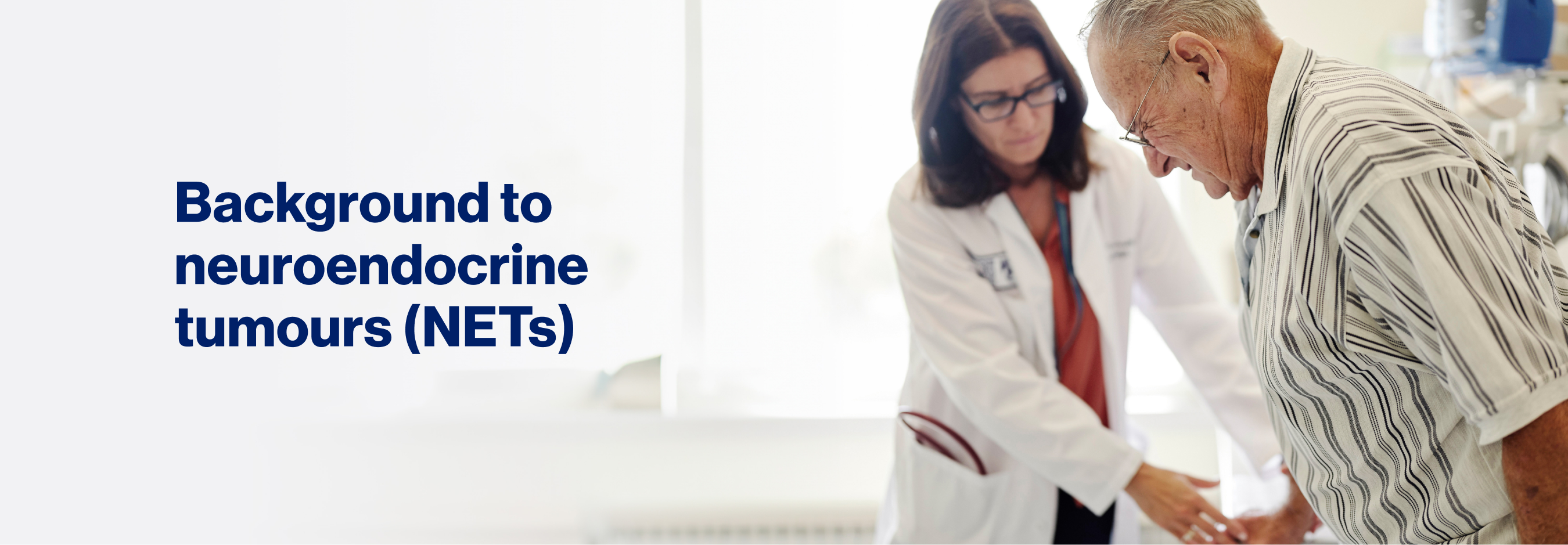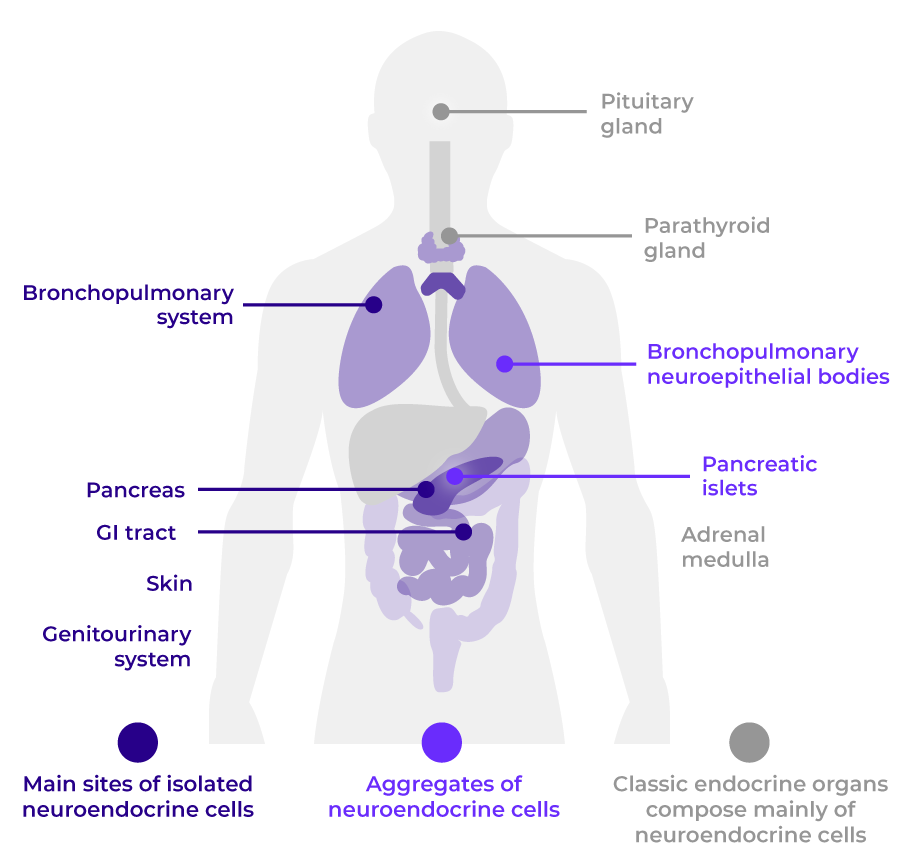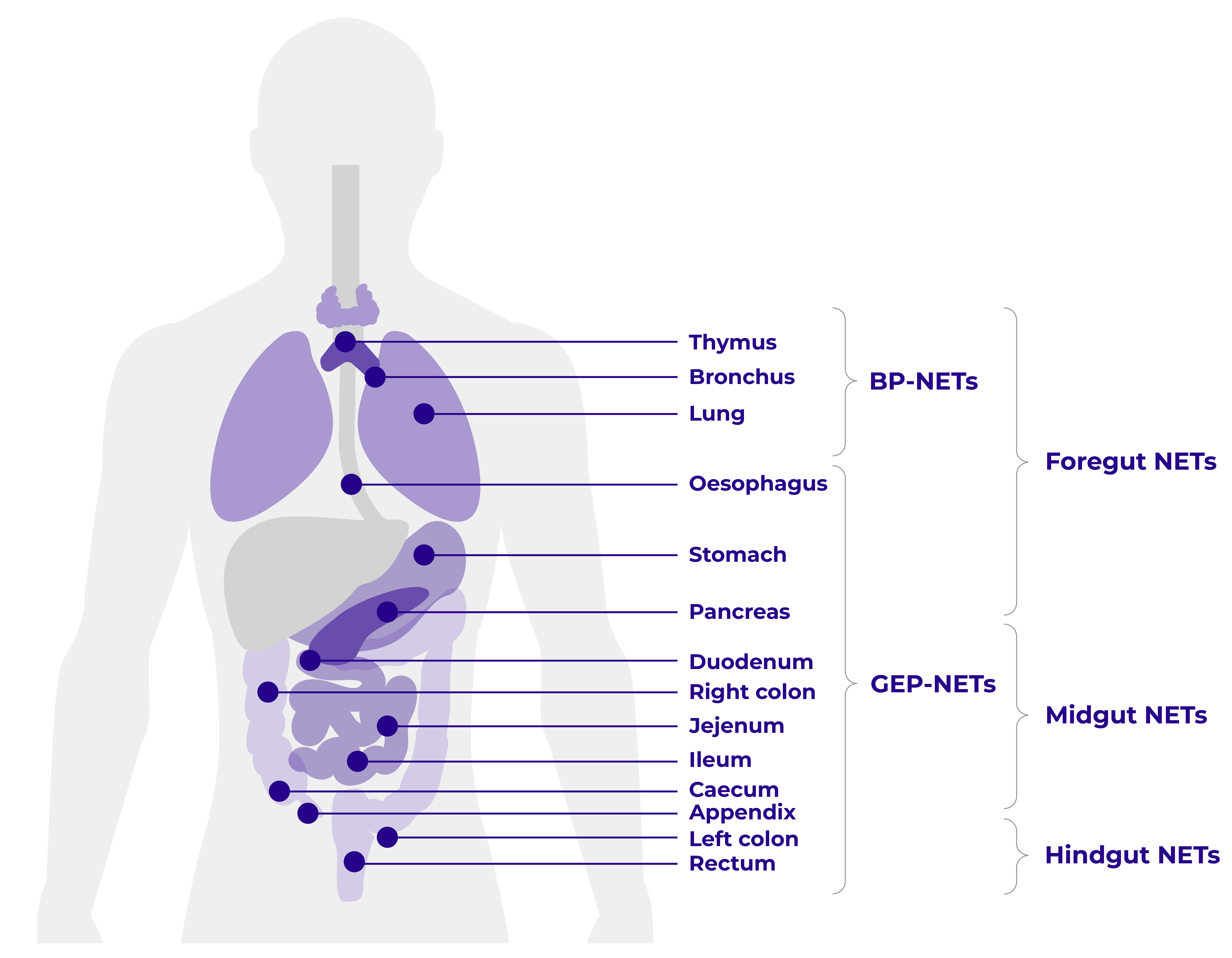
What you need to know

Adapted from Canadian Cancer Society.1
Definition and distribution of NETs
NETs are a group of neoplasms that originate in secretory cells known as neuroendocrine cells, which are distributed throughout the body.1,2
They are located in three broad areas:
Isolated neuroendocrine cells, scattered throughout most tissues1,3
Aggregates of neuroendocrine cells in organs3
Classic endocrine glands1

Adapted from Oronsky B, et al. 2017.5
Anatomical classification of NETs
NETs are classified according to their anatomical site of origin, with the vast majority arising in the gastroenteropancreatic (GEP) or bronchopulmonary (BP) tracts (GEP-NETs and BP-NETs, respectively).4
NETs are traditionally subclassified according to the embryological origin of their site:5
Foregut
Midgut
Hindgut
The nature of NETs
Not only do NETs differ in their anatomical site, they also vary in their level of differentiation and ‘aggressiveness’ (grading).4,6
Differentiation
Refers to the extent to which tumour cells morphologically resemble healthy cells from the same tissue4,6
By definition, NETs are well-differentiated7
NETs are usually organised into well-developed architectural patterns5,8
The invasive and metastatic potential of NETs is variable7
Grading
NETs are given a histological grade which refers to the aggressiveness of the tumour, i.e., G1, G2 or G34
Higher-grade tumours are associated with negative patient outcomes8,9
Well-differentiated NETs are nearly always G1 or G2 (though some can be G3); poorly differentiated tumours are referred to as neuroendocrine carcinomas (NECs) and are always G34,7
Functioning and non-functioning NETs2,4,10
In the case of NETs, increased proliferation of neuroendocrine cells sometimes leads to hypersecretion of hormones.4 When NETs cause clinical symptoms due to hormone hypersecretion, they are described as ‘functioning’. However, most NETs do not produce biologically active hormones and are termed ‘non-functioning’.4
Type of functioning NET | Hormone(s) secreted | Anatomical site |
Functioning carcinoid | Serotonin, tachykinin, prostaglandins, 5-hydroxytryptophan, histamine | Small intestine, lung or pancreas |
ACTHoma | Adrenocorticotropic hormone (ACTH) | Pancreas, bronchus, thymus |
Insulinoma | Insulin | Pancreas |
Gastrinoma | Gastrin | Gastrinoma triangle |
Glucagonoma | Glucagon | Pancreas |
PPoma | Pancreatic polypeptide (PP) | Pancreas |
Somatostatinoma | Somatostatin | Pancreas/duodenum |
VIPoma | Vasoactive intestinal peptide (VIP) | GEP tract, adrenal gland |
Incidence of NETs
Historically considered as rare tumours, NETs are becoming increasingly common.11 NET incidence has increased >500% in the last three decades. Approximately 6 in every 100,000 people will develop a NET.11
In the UK:
The age-adjusted incidence of GEP-NETs increased 3.8- to 4.8-fold from 1973 to 200712
In England specifically, neuroendocrine neoplasm (NEN) incidence rose to 9.37 per 100,000 in 2016, remaining at a similar rate in 201713

Adapted from White BE, et al. 2019.13
Symptoms of NETs
The majority of NETs are non-functioning and symptoms, if they do occur, tend to be vague and non-specific.4,5
Symptoms associated with BP-NETs
BP-NETs are associated with wheezing, coughing, haemoptysis, dyspnoea, chest pain and recurrent pneumonia4,5,14
Peripherally located lung NETs are usually asymptomatic5
Symptoms associated with GEP-NETs
The most prominent symptoms are abdominal pain and change in bowel habit (due to mass effects of the tumour causing intermittent bowel obstruction)4,14
Fatigue is particularly prevalent in those with pancreatic NETs14
ACTH, adrenocorticotropic hormone; BP, bronchopulmonary; GEP, gastroenteropancreatic; GI, gastrointestinal; NEC, neuroendocrine carcinoma; NEN, neuroendocrine neoplasm; NET, neuroendocrine tumour; PP, pancreatic polypeptide; VIP, vasoactive intestinal peptide.
References
Canadian Cancer Society. The neuroendocrine system. Available at: https://cancer.ca/en/cancer-information/cancer-types/neuroendocrine/what-is-neuroendocrine-cancer/the-neuroendocrine-system [Accessed October 2025].
Kidd M, et al. Cell Mol Gastroenterol Hepatol 2015;1:131–153.
Ameri P & Ferone D. Neuroendocrinology 2012;95:267–276.
Raphael M, et al. CMAJ 2017;189:E398–E404.
Oronsky B, et al. Neoplasia 2017;19:991–1002.
Chung C. Am J Health Syst Phar 2016;73:1729–1744.
Rindi G, et al. Mod Pathol 2018;31:1770–1786.
Cavalcanti M, et al. Int J Endocr Oncol 2016;3:203–219.
Dasari A, et al. JAMA Oncol 2017;3:1335–1342.
Asha H, et al. Indian J Endocrinol Metab 2011;15:346–348.
Frilling A, et al. Endocr Relat Cancer 2012;19:R163–R185.
Fraenkel M, et al. Endocr Relat Cancer 2014;21:R153–R163.
White BE, et al. Endocr Abstr 2019; 68:OC3.
Basuroy R, et al. Neuroendocrinology 2018;107:42–49.
UK | October 2025 | FA-11462546
Adverse events should be reported. Reporting forms and information can be found at www.mhra.gov.uk/yellowcard. Adverse events should also be reported to Novartis online through the pharmacovigilance intake (PVI) tool at www.novartis.com/report, or alternatively email [email protected] or call 01276 698370.

